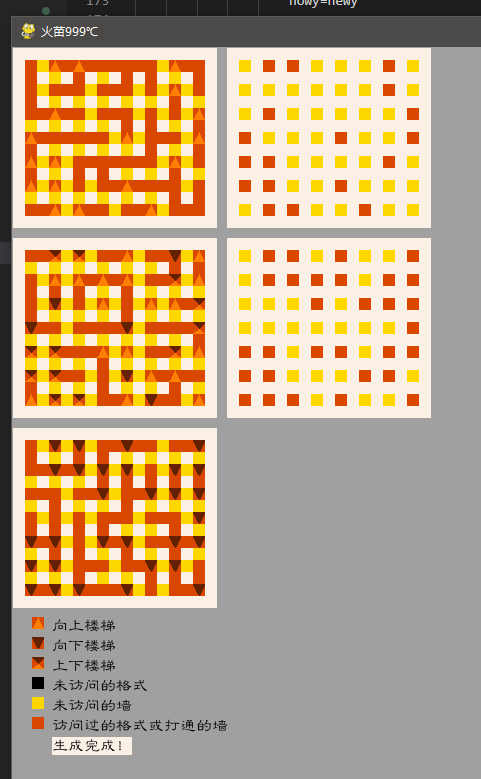1
2
3
4
5
6
7
8
9
10
11
12
13
14
15
16
17
18
19
20
21
22
23
24
25
26
27
28
29
30
31
32
33
34
35
36
37
38
39
40
41
42
43
44
45
46
47
48
49
50
51
52
53
54
55
56
57
58
59
60
61
62
63
64
65
66
67
68
69
70
71
72
73
74
75
76
77
78
79
80
81
82
83
84
85
86
87
88
89
90
91
92
93
94
95
96
97
98
99
100
101
102
103
104
105
106
107
108
109
110
111
112
113
114
115
116
117
118
119
120
121
122
123
124
125
126
127
128
129
130
131
132
133
134
135
136
137
138
139
140
141
142
143
144
145
146
147
148
149
150
151
152
153
154
155
156
157
158
159
160
161
162
163
164
165
166
167
168
169
170
171
172
173
174
175
176
177
178
179
180
181
182
183
184
185
186
187
188
189
190
191
192
193
194
195
196
197
198
199
200
201
202
203
204
205
206
|
import random
from maze import *
from draw_maze import *
def wilson_maze_demo(levels, rows, cols):
if 0 == levels % 2:
levels+=1
if 0 == rows % 2:
rows+=1
if 0 == cols % 2:
cols+=1
maze_map = maze_init_draw(levels, rows, cols)
x=1
y=1
z=0
tmpgrids = []
tmpwalls = []
notusegrids = []
for tz in range(0, levels):
for tx in range(0, cols):
for ty in range(0, rows):
if maze_map[tx][ty][tz] == CELL_NO_VISIT:
notusegrids.append((tx,ty,tz))
elif maze_map[tx][ty][tz] == WALL_NO_VISIT:
maze_map[tx][ty][tz] = WALL_VISIT
nowx,nowy,nowz = random.choice(notusegrids)
notusegrids.remove((nowx,nowy,nowz))
maze_map[nowx][nowy][nowz]=CELL_VISIT
nowx,nowy,nowz = notusegrids[0]
tmpgrids.append((nowx,nowy,nowz))
posx,posy=None,None
while True:
for event in pygame.event.get():
if event.type == pygame.QUIT:
return
if notusegrids:
directions = []
if nowy > 1:
directions.append('f')
if nowx > 1:
directions.append('l')
if nowy < rows-2:
directions.append('b')
if nowx < cols-2:
directions.append('r')
if nowz < levels-1:
directions.append('u')
if nowz > 0:
directions.append('d')
if len(directions):
move = random.choice(directions)
if move == 'f':
newy = nowy-2
newx = nowx
newz = nowz
opwall=(nowx,nowy-1,nowz)
nextgrid=(newx,newy,newz)
if move == 'l':
newy = nowy
newx = nowx-2
newz = nowz
opwall=(nowx-1,nowy,nowz)
nextgrid=(newx,newy,newz)
if move == 'b':
newy = nowy+2
newx = nowx
newz = nowz
opwall=(nowx,nowy+1,nowz)
nextgrid=(newx,newy,newz)
if move == 'r':
newy = nowy
newx = nowx+2
newz = nowz
opwall=(nowx+1,nowy,nowz)
nextgrid=(newx,newy,newz)
if move == 'u':
newy = nowy
newx = nowx
newz = nowz+2
opwall=(nowx,nowy,nowz+1)
nextgrid=(newx,newy,newz)
if move == 'd':
newy = nowy
newx = nowx
newz = nowz-2
opwall=(nowx,nowy,nowz-1)
nextgrid=(newx,newy,newz)
if (newx, newy, newz) in tmpgrids:
i = tmpgrids.index((newx, newy, newz))
tmpgrids=tmpgrids[:i+1]
tmpwalls=tmpwalls[:i]
nowx=newx
nowy=newy
nowz=newz
elif maze_map[newx][newy][newz] != CELL_NO_VISIT:
tmpwalls.append(opwall)
for (x,y,z) in tmpgrids:
notusegrids.remove((x,y,z))
if maze_map[x][y][z]==CELL_NO_VISIT:
maze_map[x][y][z]=CELL_VISIT
else:
print("x")
for (x,y,z) in tmpwalls:
maze_map[x][y][z]=NOWALL
if z%2 == 1:
if maze_map[x][y][z-1] == CELL_VISIT:
maze_map[x][y][z-1]=STAIRS_U
elif maze_map[x][y][z-1] == STAIRS_D:
maze_map[x][y][z-1]=STAIRS_UD
if maze_map[x][y][z+1] == CELL_VISIT:
maze_map[x][y][z+1]=STAIRS_D
elif maze_map[x][y][z+1] == STAIRS_U:
maze_map[x][y][z+1]=STAIRS_UD
else:
maze_map[x][y][z]=NOWALL
tmpgrids=[]
tmpwalls=[]
if notusegrids:
nowx,nowy,nowz = notusegrids[0]
tmpgrids.append((nowx,nowy,nowz))
else:
tmpgrids.append(nextgrid)
tmpwalls.append(opwall)
nowx=newx
nowy=newy
nowz=newz
draw_maze(maze_map, levels, rows, cols, (nowx,nowy,nowz), not notusegrids)
if tmpgrids:
for (xi,yi,zi) in tmpgrids:
a = zi % 2
b = zi // 2
px, py = 1 + xi * DIAMOND_SIZE[0] + a * (cols*DIAMOND_LENGTH+10), 1 + yi * DIAMOND_SIZE[1] + b*(rows*DIAMOND_LENGTH+10)
screen.blit(DIAMOND_W, (px, py))
if tmpwalls:
for (xi,yi,zi) in tmpwalls:
a = zi % 2
b = zi // 2
px, py = 1 + xi * DIAMOND_SIZE[0] + a * (cols*DIAMOND_LENGTH+10), 1 + yi * DIAMOND_SIZE[1] + b*(rows*DIAMOND_LENGTH+10)
screen.blit(DIAMOND_W, (px, py))
time_passed = clock.tick(30)
pygame.display.update()
return
if __name__ == "__main__":
'''main'''
wilson_maze_demo(5, 15, 17)
|







